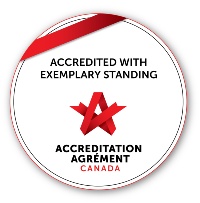Be Sun Safe
While Canadians look forward to spending time in the sun, ultraviolet light from the sun damages our skin and can lead to skin cancer.
Did you know the most common cancer in Canada is skin cancer? Rates are rising across the country, but there is good news. Although exposure to ultraviolet (UV) light cause 50-90% of skin cancers, those numbers also mean that skin cancers are one of the most preventable. Sources of UV light include the sun and UV-emitting appliances such as tanning beds. UVA rays are associated more with wrinkles and skin aging, while UVB rays are linked to sunburn. Both types of rays damage the skin and are harmful to the eyes.
In its efforts to promote awareness about the damage sun can cause, CancerCare Manitoba can show you first-hand evidence with its special UV detect camera. The camera has a dual lens providing an image in two frames – one a standard photo of a person and another that reveals the UV damage people have accumulated over time.
During the summer at various community events, CCMB staff will have the UV detect camera at its sun/UV safety booth. Drop by and let us take your picture!
Here are some facts that can help you stay safer in the sun (PDF).

Sun Safe Tips
Clothing
UV rays are the strongest between 11 a.m. and 3 p.m. so you need to protect your skin by seeking shade and wearing clothing that covers as much skin as possible. Tightly woven clothing or apparel that’s labelled UV-protective is recommended.
Many skin cancers develop at the back of the neck and behind the ears so it’s important to wear a wide-brimmed hat, which also adds protection for your eyes.
Don’t assume cloudy days make a difference; clouds can let through up to 80% of the sun’s UV rays.
Eye Protection
While UV rays are more intense between April and September in Canada, it’s important to wear sunglasses or prescription eyeglasses with UV-protective lenses year-round.
Close-fitting, wraparound sunglasses offer the best protection, but try to choose sunglasses or prescription lenses that have full UVA and UVB protection. Examples of appropriate labels are "UV400" or "100% UV protection."
Sunscreen
When purchasing sunscreen, choose one labelled "broad spectrum" and "water-resistant" with a sun-protection factor (SPF) of at least 30.
SPF refers to the protection against UVB rays, but UVA rays are also harmful so look for the broad-spectrum label to take into account both types.
Sunscreen should be applied generously. The average adult requires about two to three tablespoons of lotion-formulated sunscreen to cover the whole body, and a teaspoon to cover the face and neck. Sunscreen should be applied under makeup and on skin not covered by clothing.
Once is not enough when it comes to using sunscreen. Reapply after swimming, strenuous exercise or towelling off.
Some people may be wary of the chemicals in sunscreens, but research shows that even if sunscreen’s ingredients could sink deep into the skin, the chemical levels are too low to be toxic to the underlying cells. However, sunscreens shouldn’t be used on babies under six months old. Their skin is much thinner than children and adults so ingredients can be more easily absorbed.
The Canadian Dermatology Association logo appears on sunscreens that have been tested for safety and effectiveness.
Seeking a Suntan
It’s a myth that having a “base tan” protects you against sun damage.
Any change to your skin's natural colour from the sun is a sign that damage has occurred. A base tan only provides protection equal to an SPF of 2-4.
Tanning Beds
Research has shown a link between UV-emitting tanning equipment and the risk of skin cancers.
Indoor tanning even once before the age of 25 increases the risk for melanoma (the most serious form of skin cancer) by 35%, while indoor tanning for more than one year increases that risk by 61%.
In 2016, Manitoba passed legislation that prohibits youth under the age of 18 from using indoor tanning equipment unless they have a prescription from a health professional.
Tanning salons must also update their warning signs and provide protective eyewear to their customers. The legislation also bans the use of tanning equipment that’s not controlled by an operator or employee who’s been instructed in the proper use of the equipment.
Vitamin D
Intentional UV exposure isn’t the way to meet vitamin D requirements. Use sources of vitamin D that are safer such as fortified foods and vitamin D supplements.

